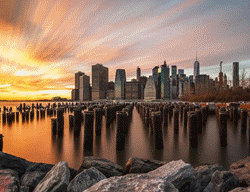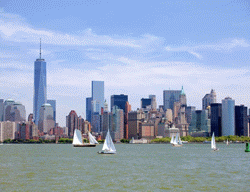美国总统唐纳德·特朗普(Donald Trump)周二抵达荷兰参加北约(NATO)峰会,就在几天前,他决定对伊朗核设施发动袭击,并在几个小时前宣布在伊朗停火以色列-伊朗冲突。这将是特朗普自1月份重返白宫以来首次面对欧洲的美国盟友。
在前往集会的途中,特朗普质疑了该联盟的一个核心租户,因为他拒绝承诺第5条-北约国家集体防御协议。
“你承诺遵守北约第五条吗?”特朗普被尖锐地问道。
“取决于你的定义。第五条有很多定义。你知道的,对吧?”特朗普声称。
“但我致力于成为他们的朋友,”他补充道。“你知道,我已经和这些领导人中的许多人成为朋友,我致力于帮助他们。”
他后来被要求澄清这些评论,因为这肯定会引起其他国家的不满。
“你们还致力于共同防御吗?”有人问他。
“我致力于拯救生命,”特朗普说。“我对生命和安全负责,到了那里我会给你一个确切的定义。我只是不想在飞机上做。”
特朗普出发前夕,伊朗对美国在卡塔尔的一个基地实施了报复性打击。特朗普周一表示,其中13枚导弹被拦截,第14枚没有击中目标。
“我很高兴地报告,没有美国人受到伤害,几乎没有任何损害,”特朗普在社交媒体上发布消息,并补充说,伊朗给了美国“提前通知”。
几个小时后,特朗普在社交媒体平台上发布消息称,两国已经同意停火,结束敌对状态。
“这场战争本可以持续数年,并摧毁整个中东,但它没有,也永远不会!”特朗普周一晚上早些时候发布了这条消息。
但在离开白宫时,特朗普周二对美国广播公司新闻(ABC News)表示,他对以色列或伊朗都“不满意”,因为据报道,这两个战斗人员之间的初步停火在开始几个小时后就被破坏了。
特朗普表示,伊朗和以色列都“违反”了停火。
特朗普说:“以色列,我们一达成协议,他们就出来扔了一船炸弹,这是我从未见过的。”“我们见过的最大负载,我对以色列不满意。”
“好吧,当我说现在你有12个小时,你不要在第一个小时出去,只是把你的一切都扔在他们身上,”总统补充道。“所以,我对他不满意。我对伊朗也不满意。”
特朗普说,他“不高兴以色列今天早上出去,因为一枚火箭没有着陆,那枚火箭可能是误射的,但没有着陆,”他指的是以色列的指控——德黑兰否认了这一指控——伊朗周二在停火生效后向以色列发射了导弹。
这场冲突无疑将在本次峰会上凸显出来,就像上周在加拿大举行的七国集团峰会一样——特朗普提前离开了峰会,以监控以色列和伊朗之间日益加剧的危机。
这次旅行将是短暂的。特朗普预计将于周二早上离开白宫,并于周三晚上返回美国。特朗普周二晚上抵达荷兰后,将直接进入盛况。他将与荷兰国王和王后一起出席在荷兰皇宫举行的正式晚宴。那天晚上,他还会拍一张北约的全家福。
周三,川普将出席北约峰会,他将参加北约家庭照片,北约秘书长马克·吕特讲话顶部的照片喷雾,然后与北约领导人举行第一次全体会议。然后,总统将花几个小时进行双边会谈,尽管目前还不知道他计划在峰会期间会见哪些领导人。特朗普随后将举行新闻发布会,届时他肯定会面临有关他下令打击伊朗核设施以及该任务影响的问题。新闻发布会结束后,特朗普将离开荷兰,返回美国。
特朗普将带着一个关键的优先事项参加会议:他希望联盟将所有成员国的国防支出从国内生产总值的2%增加到5%。在新的中东冲突之前,这一直是特朗普的标志性问题。总统长期以来一直抱怨美国一直在补贴其盟友的防务,甚至威胁说,他不会为没有完全支付费用的国家提供防务,这完全背离了北约第五条,该条规定,对一个国家的攻击就是对所有国家的攻击。
特朗普的批评可以追溯到2017年北约峰会,当时他指责欧洲同行未能支付他所说的“公平份额”。
尽管特朗普的高级顾问表示有信心在今年的峰会上投票通过5%的门槛,但西班牙等一些国家有其他计划。西班牙首相周末宣布,该国达成了一项协议,允许其在不满足新的国防支出门槛的情况下留在北约,而是仅贡献该国国内生产总值的2.1%。
特朗普对此次会议还有其他几个目标,包括敦促联盟成员重振关键矿产和武器的工业能力,以及与世界领导人举行双边会议,以重申对盟友的承诺,一名高级政府官员上周在一次电话会议上表示,预览此次访问。
自特朗普上次参加北约峰会以来,俄罗斯入侵了乌克兰。乌克兰战争已经持续了三年多,特朗普一再声称,如果他在任,就不会发生这种情况。他还将这场战争归咎于乌克兰对加入北约的渴望。自战争以来,乌克兰总统弗拉基米尔·泽连斯基一直是北约峰会的特邀嘉宾,包括前总统乔·拜登去年在华盛顿举办的峰会,但据报道,泽连斯基今年的参与将是有限的,包括没有席位。
这也是特朗普第二任期的首次北约峰会,这是他在第一任期内尖锐批评的联盟中的一次重现。此前,许多北约领导人已经返回白宫举行双边会议,讨论关键问题,并获得特朗普的青睐。在中东冲突日益加剧的阴影下,世界领导人将密切关注特朗普将如何在第二任期实施他的“美国第一”政策,以及该政策将如何影响美国的海外联盟。
Trump attends NATO summit after US strikes on Iran and a ceasefire in question
President Donald Trump arrived Tuesday in the Netherlands for a NATO summit, just days after he made the decision to launch strikes on Iranian nuclear sites and hours after he announced a ceasefire in theIsrael-Iran conflict. It will be the first time Trump will face European U.S. allies since returning to the White House in January.
On his way to the gathering, Trump questioned a core tenant of the alliance as he refused to commit to Article 5 -- the agreement of collective defense among NATO nations.
"Are you committed to Article 5 of NATO?" Trump was pointedly asked.
"Depends on your definition. There's numerous definitions of Article Five. You know that, right?" Trump claimed.
"But I'm committed to being their friends," he added. "You know, I've become friends with many of those leaders, and I'm committed to helping them."
He was later asked to clarify those comments given the eyebrows it's sure to raise among other nations.
"Are you still committed to mutual defense?" he was asked.
"I'm committed to saving lives," Trump said. "I'm committed to life and safety, and I'm going to give you an exact definition when I get there. I just don't want to do it on the back of an airplane."
On the eve of Trump's departure, Iran carried out retaliatory strikes at a U.S. base in Qatar. Trump said Monday that 13 of those missiles were intercepted and a 14th was off target.
"I am pleased to report that NO Americans were harmed, and hardly any damage was done," Trump posted on social media, adding that Iran gave the U.S. "early notice."
Then hours later, Trump posted on his social media platform that the two countries had agreed to a ceasefire that would end hostilities.
"This is a War that could have gone on for years, and destroyed the entire Middle East, but it didn't, and never will!" Trump posted early Monday evening.
But as left the White House, Trump told ABC News on Tuesday he is "not happy" with either Israel or Iran after the opening hours of a nascent ceasefire between the two combatants were marred by reported exchanges.
Trump said Iran and Israel both "violated" the ceasefire.
"Israel, as soon as we made the deal, they came out and dropped a boat load of bombs the likes of which I've never seen before," Trump said. "The biggest load that we've seen, I'm not happy with Israel."
"OK, when I say now you have 12 hours, you don't go out in the first hour and just drop everything you have on them," the president added. "So, I'm not happy with him. I'm not happy with Iran either."
Trump said he was "unhappy if Israel is going out this morning because of one rocket that didn't land, that was shot perhaps by mistake, but didn't land," referring to Israeli allegations -- denied by Tehran -- that Iran fired missiles toward Israel on Tuesday after the ceasefire came into effect.
The conflict will undoubtedly loom large over this summit just as it did with the G7 summit in Canada last week -- which Trump left early to monitor the growing crisis between Israel and Iran back at the White House.
The trip will be brief. Trump is expected to leave the White House early Tuesday morning and return to the U.S. on Wednesday evening. Upon his arrival in the Netherlands on Tuesday night, Trump will head straight into the pomp and circumstance. He will attend a formal dinner at the Netherlands Royal Palace alongside the King and Queen of the Netherlands. He will also take a NATO family photo that evening.
On Wednesday, Trump will attend the NATO summit where he will participate in a NATO family photo, a photo spray at the top of NATO Secretary General Mark Rutte's remarks and then the first plenary session with NATO leaders. The president will then spend a few hours engaged in bilateral meetings, although it is not not yet known which leaders he plans to meet with on the sidelines of the summit. Trump will then hold a news conference where he will surely face questions about his order to strike Iranian nuclear sites and the impact of that mission. After the news conference, Trump is set to leave the Netherlands and return to the U.S.
Trump is going into the conference with a key priority: he wants the alliance to codify an increase in defense spending across all member nations, from 2% of their gross domestic product to 5%. This has been a signature issue for Trump well before the new Middle East conflict. The president has long complained that the U.S. has been subsidizing the defense of its allies -- and has even gone so far as threatening that he would not come to the defense of nations not fully paying their way, a radical departure from NATO's Article 5, which says an attack on one is an attack on all.
Trump's criticisms go back as far as the 2017 NATO summit, when he accused his European counterparts of failing to pay what he said was their "fair share."
Though Trump's top advisers have signaled confidence that the 5% threshold will be agreed to by a vote at this year's summit, some nations like Spain have other plans. Spain's prime minister announced over the weekend that it forged an agreement that will allow it to remain in NATO without meeting the new defense spending threshold, instead contributing only 2.1% of the nation's GDP.
Trump has a few other aims for the conference, including urging alliance members to revitalize their industrial capacities for critical minerals and weapons and bilateral meetings with world leaders to reaffirm a commitment to allies, a senior administration official said last week in a call previewing the trip.
In the time since Trump last attended a NATO summit, Russia invaded Ukraine. The war in Ukraine has raged on for more than three years and Trump has repeatedly claimed it would not have happened if he were in office. He has also blamed the war on Ukraine's desire to join NATO. Ukrainian President Volodymyr Zelenskyy has been a featured guest at NATO summits since the war, including the one former President Joe Biden hosted in Washington last year, but it's reported that Zelenskyy's involvement will be limited this year -- including not having a seat at the table.
This is also Trump's first NATO summit of his second term, a reemergence in the alliance that he sharply criticized during his first term. It also comes after many NATO leaders have already returned to the White House for bilateral meetings to discuss key issues and to gain favor with Trump. Under the shadow of the growing conflict in the Middle East, world leaders will be watching closely for how Trump will enact his America First policy in his second term and how that policy will impact American alliances overseas.





